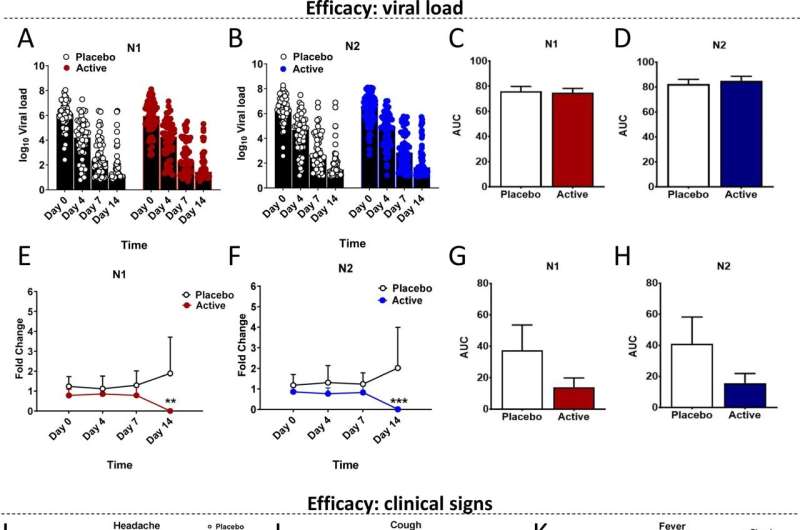This article has been reviewed according to Science X's editorial process and policies. Editors have highlighted the following attributes while ensuring the content's credibility:
fact-checked
proofread
Clinical trial investigates new oral treatment for COVID-19

An exploratory clinical trial (SIGMA4COVID) through a collaboration between Catalonia and Galicia, the results of which are published in the Journal of Infection, suggests the usefulness of a drug, E-52862, for the treatment of patients with mild COVID-19 symptoms. If these findings are confirmed, it will be one of the few useful treatments in these cases, with the addition that it could be administered on an outpatient basis through primary care centers.
The study included Hospital del Mar in Barcelona, the Neuropharmacology Laboratory of the Department of Medicine and Life Sciences (MELIS) at Pompeu Fabra University, the Pere Virgili Health Park in Barcelona, the Health Research Institute of Santiago de Compostela, the University Clinical Hospital of Santiago, Barbanza Hospital, and the A Estrada Health Center, Galicia, as well as ESTEVE.
E-52862 is an investigational drug discovered by ESTEVE and was initially designed to treat neuropathic pain. It acts on the SIGMA1 receptor, located inside the cell, and which—in the case of COVID-19—is a basic factor for the start of viral replication that causes the disease SARS-CoV-2.
As explained by Dr. Rafael Maldonado, director of the Neuropharmacology Laboratory at UPF, co-last author of the study and corresponding author, "the drug is an antagonist of the SIGMA1 receptor, it binds to it, interfering in the binding of proteins of the virus with this receptor, causing a disruption of this hypothetical binding and blocking its replication mechanism."
Dr. José Miquel Vela, director of Research at Welab Barcelona (a drug discovery platform linked to the Leitat Technology Center), co-first author of the study and originator of the idea that drove it, adds that "overwhelmed by a pandemic... something had to be done, and what better contribution could scientists make than to investigate the effect of a potentially effective treatment against COVID-19?"
Reduced symptoms of infection
The trial involved 120 volunteers, all diagnosed with mild COVID-19. Approximately half were given the drug, and the rest were given a placebo. Recruitment was carried out between February 2021 and July 2022 at the primary health care centers of Vila Olímpica, Larrard, and Barceloneta, which belong to the Pere Virgili Health Park and the A Estrada Health Center in Santiago de Compostela, as well as the emergency services of the Clinical Hospital of Santiago and Barbanza Hospital.
"Recruiting patients was a challenge," notes Dr. Alba Gurt, a doctor at the Vila Olímpica primary health care center of the Pere Virgili Health Park in Barcelona and one of the signatories of the paper. "Monitoring was carried out under very complex conditions and was the result of the collaboration of a highly involved group of professionals," she adds.
Participants received the treatment at home, prepared and randomized at the Hospital del Mar Pharmacy Service. They had to take it daily for 14 days.
The results indicate that although no decrease in viral load was demonstrated compared to patients who took the placebo, it was observed that some of the most common symptoms were reduced more quickly in subjects who took E-52862. Thus, headache was reduced by a higher percentage in the subjects who received the compound compared to those who received a placebo, with a higher percentage of subjects without headache as of the fourth day of treatment. Coughing and a sore throat were also reduced, also residual symptoms in many patients who suffer COVID-19.
Dr. Santi Grau, director of the Pharmacy Department at Hospital del Mar and first signatory of the work, highlights the importance of the results. "COVID-19 is a disease that will not go away and will remain with us, both in summer and in winter. Therefore, having a drug for something that is part of our lives is very good news," he explains.
In addition, and although studies are required in a larger number of patients, E-52862 seems to have a lower profile of interactions with other drugs than some of the antivirals currently used in this type of patients.
In this regard, UAB professor Elena Martín-García, co-last senior author of the study and a senior researcher with the UPF Neuropharmarcology Research Group, points out that "blocking the SIGMA1 receptor prevents the replication of the virus by a mechanism that does not depend on the portion of SARS-CoV-2 that is modified in its different variants, thus being able to be similarly effective against the different strains of the virus."
Dr. Mabel Loza, co-author of the study and principal investigator of the Biopharma group of the Health Research Institute of Santiago de Compostela, highlights "the milestone represented by the trial of an oral administration drug, the first created in Spain, on COVID-19; fruit of previous public-private preclinical collaborative research work and now also in clinical research, of the hospital's emergency service and primary care centers, so meritorious in times of pandemic."
The lead author of the study and head of the Rheumatology Department at Hospital del Mar, Dr. Jordi Monfort adds that "the purpose of this study was to treat patients who start with COVID-19 with mild symptoms to prevent them from getting worse and requiring hospital care. And it looks like E-52682 may manage this. There are almost no other drugs of this type for primary care administration and avoid greater pressure on the system, hence their importance." At the same time, it is a drug that is easily handled and administered by the primary health care network.
According to the researchers, these findings highlight a new mechanism of action for the treatment of COVID-19, which could also prove useful for other viral infections.
More information: Santiago Grau et al, Efficacy of SIGMAR1-based therapy in the early treatment of confirmed mild symptomatic COVID-19 patients, Journal of Infection (2023). DOI: 10.1016/j.jinf.2023.11.008



















